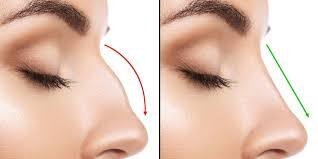
Revision Rhinoplasty
Introduction:
Explain the purpose of revision rhinoplasty, which is to address functional or aesthetic concerns that remain after a previous rhinoplasty.
Highlight the challenges associated with revision rhinoplasty due to the altered nasal anatomy and potential scar tissue from the initial surgery.
Common Reasons for Revision Rhinoplasty:
Discuss common issues that may lead to the need for revision rhinoplasty, such as unsatisfactory cosmetic outcomes, breathing difficulties, asymmetry, persistent nasal deformities, or functional impairments.
Address the emotional and psychological impact that an unsatisfactory rhinoplasty outcome can have on the patient.
Preparing for Revision Rhinoplasty:
Explain the importance of a comprehensive consultation with an experienced and skilled facial plastic surgeon to evaluate the specific concerns and discuss realistic expectations.
Discuss the assessment process, which may include a thorough examination of the nose, a review of the previous surgery records, and possibly imaging or diagnostic tests.
Emphasize the need for open communication between the patient and the surgeon to ensure a clear understanding of the desired outcomes and limitations of the revision procedure.
The Revision Rhinoplasty Procedure:
Describe the surgical techniques commonly used in revision rhinoplasty, such as cartilage grafting, reshaping or repositioning of nasal structures, septal reconstruction, or refinement of the nasal tip.
Explain the challenges associated with the revision procedure, including the need to address scar tissue, compromised blood supply, and limited availability of grafting materials.
Highlight the importance of individualized surgical plans tailored to the specific concerns and anatomy of each patient.
Recovery and Postoperative Care:
Discuss the typical recovery process after revision rhinoplasty, including the duration of swelling, bruising, and discomfort.
Provide postoperative care instructions, such as keeping the head elevated, avoiding strenuous activities, and following any prescribed medications.
Mention the importance of regular follow-up visits with the surgeon to monitor healing progress and address any concerns or complications that may arise.
Realistic Expectations:
Emphasize the importance of having realistic expectations for revision rhinoplasty, as the degree of improvement may vary depending on the individual case and the limitations of the previous surgery.
Discuss the potential need for additional revisions in some cases, as achieving the desired outcomes may require staged procedures or further refinement.
Risks and Complications:
Acknowledge the potential risks and complications associated with revision rhinoplasty, such as infection, bleeding, poor wound healing, persistent asymmetry, breathing difficulties, or changes in sensation.
Encourage patients to choose a qualified and experienced facial plastic surgeon who specializes in revision rhinoplasty to minimize the risks and maximize the chances of achieving satisfactory outcomes.
Conclusion:
Summarize the purpose and significance of revision rhinoplasty in addressing unsatisfactory results or functional issues after a previous rhinoplasty.
Encourage individuals considering revision rhinoplasty to seek consultation with a skilled facial plastic surgeon to discuss their specific concerns and explore the possibilities of improving their nasal aesthetics and function.
Unsuccessful primary Rhinoplasty, post operative infections or an over aggressive surgery and unpredictable post operative healing are few common causes of an undesirable result. Revision Rhinoplasty has its own limitations because of the scarred tight skin and soft tissues. The limited availability of graft materials mandates for harvesting grafts from other sites like ear, rib, temporalis fascia. Introduction: Explain the purpose of revision rhinoplasty, which is to address functional or aesthetic concerns that remain after a previous rhinoplasty. Highlight the challenges associated with revision rhinoplasty due to the altered nasal anatomy and potential scar tissue from the initial surgery. Common Reasons for Revision Rhinoplasty: Discuss common issues that may lead to the need for revision rhinoplasty, such as unsatisfactory cosmetic outcomes, breathing difficulties, asymmetry, persistent nasal deformities, or functional impairments. Address the emotional and psychological impact that an unsatisfactory rhinoplasty outcome can have on the patient. Preparing for Revision Rhinoplasty: Explain the importance of a comprehensive consultation with an experienced and skilled facial plastic surgeon to evaluate the specific concerns and discuss realistic expectations. Discuss the assessment process, which may include a thorough examination of the nose, a review of the previous surgery records, and possibly imaging or diagnostic tests. Emphasize the need for open communication between the patient and the surgeon to ensure a clear understanding of the desired outcomes and limitations of the revision procedure. The Revision Rhinoplasty Procedure: Describe the surgical techniques commonly used in revision rhinoplasty, such as cartilage grafting, reshaping or repositioning of nasal structures, septal reconstruction, or refinement of the nasal tip. Explain the challenges associated with the revision procedure, including the need to address scar tissue, compromised blood supply, and limited availability of grafting materials. Highlight the importance of individualized surgical plans tailored to the specific concerns and anatomy of each patient. Recovery and Postoperative Care: Discuss the typical recovery process after revision rhinoplasty, including the duration of swelling, bruising, and discomfort. Provide postoperative care instructions, such as keeping the head elevated, avoiding strenuous activities, and following any prescribed medications. Mention the importance of regular follow-up visits with the surgeon to monitor healing progress and address any concerns or complications that may arise. Realistic Expectations: Emphasize the importance of having realistic expectations for revision rhinoplasty, as the degree of improvement may vary depending on the individual case and the limitations of the previous surgery. Discuss the potential need for additional revisions in some cases, as achieving the desired outcomes may require staged procedures or further refinement. Risks and Complications: Acknowledge the potential risks and complications associated with revision rhinoplasty, such as infection, bleeding, poor wound healing, persistent asymmetry, breathing difficulties, or changes in sensation. Encourage patients to choose a qualified and experienced facial plastic surgeon who specializes in revision rhinoplasty to minimize the risks and maximize the chances of achieving satisfactory outcomes. Conclusion: Summarize the purpose and significance of revision rhinoplasty in addressing unsatisfactory results or functional issues after a previous rhinoplasty. Encourage individuals considering revision rhinoplasty to seek consultation with a skilled facial plastic surgeon to discuss their specific concerns and explore the possibilities of improving their nasal aesthetics and function.